





In recent years, the demand for self ordering kiosk in restaurants has surged, driven by the increasing need for efficiency, customer convenience, and digital transformation in the food service industry. Quick-service restaurants (QSRs) and casual dining establishments are turning to self ordering kiosk to streamline the ordering process, reduce labor costs, and improve order accuracy. With the rising costs of labor and the growing consumer expectation for faster and more personalized service, these kiosks provide a valuable solution, allowing customers to place orders at their own pace, customize their selections, and complete transactions independently.
The following sections will explore various aspects of self-ordering kiosks for restaurants, including their key features, benefits, installation processes, and cost considerations, helping restaurant owners understand how this technology can enhance operations and customer satisfaction. The main contents include:
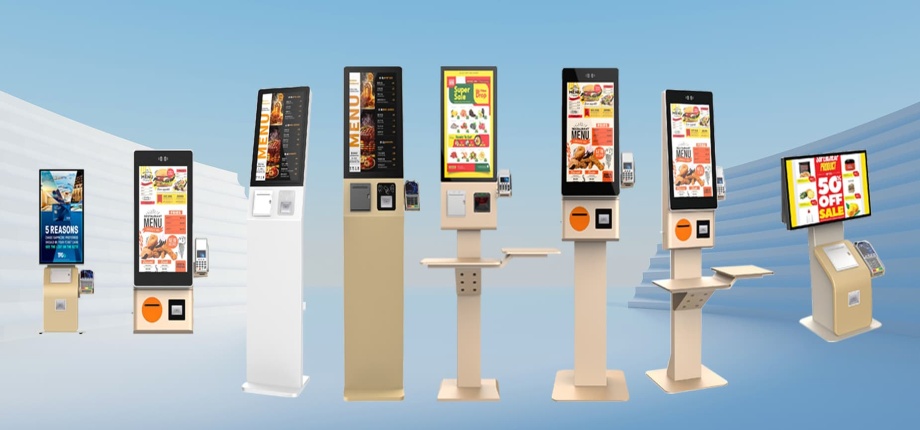
Self ordering kiosk for restaurants is an interactive digital interface that enables customers to place orders and make payments without direct interaction with staff. These kiosks streamline the ordering process, allowing customers to customize their meals, select options, and pay using various methods such as credit cards, mobile wallets, or cash.
Equipped with user-friendly touch screens, self ordering kiosk enhances the customer experience by reducing wait times and minimizing errors in order-taking. They often include features like visual menus, promotional displays, and loyalty program integration, making them effective tools for increasing order accuracy and driving sales.
As a professional kiosk manufacturer, we recognize the growing demand for self ordering kiosks, driven by the need for efficiency in the fast-paced restaurant environment. By adopting this technology, restaurants can improve operational efficiency, enhance customer satisfaction, and ultimately increase their revenue.
| Specification | Details |
| Display Type | 15" to 32" Touch Screen LCD/LED |
| Resolution | 1920 x 1080 (Full HD) or higher |
| Operating System | Windows, Android, or Linux-based systems |
| Processor | Intel i3/i5/i7 or equivalent ARM processors |
| RAM | 4GB to 8GB |
| Storage | 128GB SSD or higher |
| Network Connectivity | Ethernet, Wi-Fi, and optional 4G/LTE |
| Payment Options | Credit/Debit card reader, NFC for mobile payments, cash acceptance (bill validators and coin dispensers) |
| Software Compatibility | POS integration, custom software solutions |
| Size and Dimensions | Varies; typically around 15” (W) x 60” (H) x 24” (D) |
| Power Supply | AC 100-240V, 50/60Hz |
| Operating Temperature | 0°C to 50°C (32°F to 122°F) |
| Build Material | Steel chassis, anti-vandal glass screen |
| User Interface | Customizable UI with visual menus and promotional displays |
| Accessibility Features | ADA compliant; features for visually impaired users |
| Multilingual Support | Supports multiple languages for diverse clientele |
| Warranty | Typically 1-3 years, depending on manufacturer |
| Maintenance | Remote monitoring and software updates |
| Integration Capabilities | Can integrate with loyalty programs, inventory management, and CRM systems |
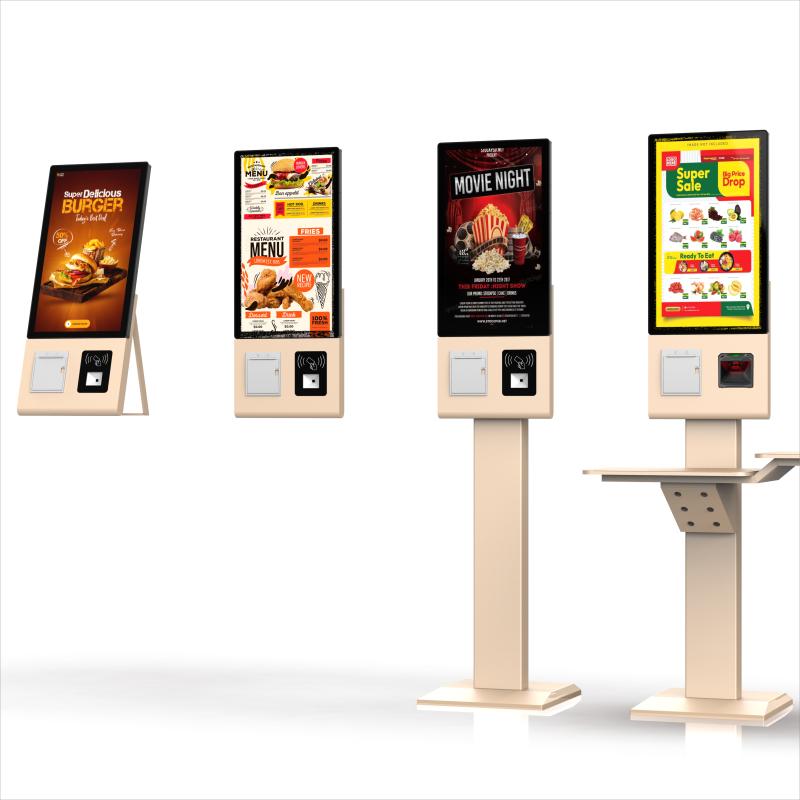
Self ordering kiosk has become essential tools in modern restaurants, enhancing customer experience and operational efficiency. Below is a detailed overview of their primary functions and features:
Self ordering kiosk for restaurants are designed with intuitive touch screens that allow customers to easily navigate menus, customize their orders, and make payments.
Touch Screen Display: High-resolution screens provide clear visibility and interaction.
Visual Menus: Attractive images and descriptions of food items help customers make informed choices.
Multilingual Support: Options for different languages cater to diverse customer bases.
A significant advantage of self ordering kiosk for restaurants is their ability to allow customers to personalize their orders.
Customizable Options: Customers can modify ingredients, portion sizes, and add extras.
Save Favorites: Frequent customers can save their preferred orders for quick reordering.
Dietary Filters: Options to filter menu items based on dietary preferences (e.g., vegetarian, gluten-free).
Self ordering kiosk for restaurants support various payment options, making transactions quick and convenient.
Credit/Debit Card Processing: Integrated card readers facilitate secure transactions.
Mobile Payments: NFC technology enables payments via mobile wallets like Apple Pay and Google Pay.
Cash Acceptance: Kiosks can include bill validators and coin dispensers for cash transactions.
Self ordering kiosk for restaurants significantly reduce the time customers spend waiting in line.
Reduced Wait Times: Customers can place orders as soon as they arrive, minimizing queues.
Faster Order Processing: Orders are directly sent to the kitchen, streamlining operations.
Table Service Options: Some kiosks allow customers to place orders for table service, improving overall efficiency.
Self ordering kiosk for restaurants can seamlessly integrate with existing Point of Sale (POS) systems, enhancing restaurant operations.
Real-Time Inventory Management: Automatic updates to inventory levels as orders are placed.
Sales Reporting: Detailed analytics on sales trends and customer preferences.
Loyalty Programs: Integration with loyalty programs helps track customer rewards and promotions.
Self ordering kiosk for restaurants can be programmed to promote specific items or deals, boosting sales.
Upselling Opportunities: Suggested add-ons or combo deals appear during the ordering process.
Seasonal Promotions: Easy to update the kiosk for holiday or special promotions.
Customer Feedback: Options for customers to provide feedback or ratings on their experience.
Self ordering kiosk for restaurants are designed with ongoing support and maintenance in mind.
Remote Monitoring: Many kiosks can be monitored remotely for issues or updates.
Software Updates: Regular updates ensure the kiosk software remains current and secure.
Technical Support: Manufacturers often provide customer support for troubleshooting and maintenance.
The functionalities and features of self ordering kiosks for restaurants significantly enhance the customer experience while improving operational efficiency. By implementing these kiosks, restaurants can meet modern consumer demands for convenience, speed, and personalization, ultimately driving higher sales and customer satisfaction.
| Style | Description | Popular Sizes | Features |
| Freestanding Kiosk | A standalone unit that can be placed anywhere in the restaurant for easy access. | 22” to 32” wide; 50” to 75” tall | Touch screen, integrated payment systems, robust design |
| Wall-Mounted Kiosk | Mounted on walls to save floor space, ideal for smaller venues. | 18” to 24” wide; 30” to 50” tall | Space-saving, touch screen, customizable graphics |
| Tabletop Kiosk | Compact units designed to sit on tables or countertops, often used in casual dining settings. | 10” to 15” wide; 10” to 20” tall | Easy access for customers, often has limited functionality |
| Dual-Sided Kiosk | Designed to serve customers from both sides, maximizing throughput during peak hours. | 36” to 48” wide; 60” to 75” tall | High traffic capacity, suitable for busy locations |
| Outdoor Kiosk | Weatherproof kiosks specifically designed for outdoor use, suitable for patios or outside venues. | 36” to 48” wide; 60” to 80” tall | Durable materials, sun-readable screens, weather-resistant |
| Custom Kiosk | Tailored to specific restaurant needs, including branding and size requirements. | Varies based on specifications | Unique designs, customized features based on brand identity |
| Multi-Function Kiosk | Combines ordering with additional functionalities, such as payment and loyalty program integration. | 24” to 36” wide; 50” to 75” tall | Versatile features, enhanced customer engagement |
Self ordering kiosk for restaurants come in various styles and sizes to meet different operational needs. Choosing the right kiosk can enhance customer experience and streamline the ordering process, contributing to greater efficiency and satisfaction. As a leading kiosk manufacturer, we emphasize the importance of selecting a style that aligns with your restaurant's layout and customer flow.
If you need further details on specific styles or sizes, feel free to ask!
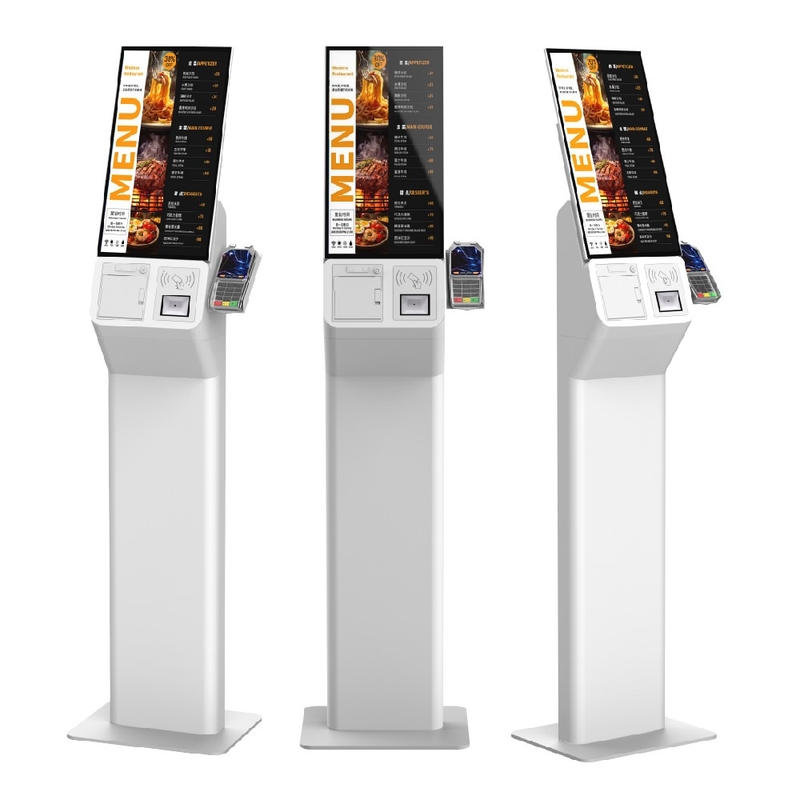
Pricing for self ordering kiosk for restaurants can vary depending on several factors, including the hardware components, software, customization, and installation. The price typically ranges from $2,500 to $10,000 per kiosk.
Hardware Specifications: Higher quality displays, processors, and additional peripherals (like NFC, barcode scanners) increase the price.
Screen Size: Larger, high-resolution touch screens are more expensive (e.g., 32-inch kiosks are pricier than 22-inch models).
Payment Systems: Integration of different payment systems, including credit card readers, cash handling units, and mobile payment options, can add significant cost.
Software: Custom or advanced software solutions tailored to specific restaurant needs can push the price higher. Licensing and regular updates also impact ongoing costs.
Customization: Branding, design modifications, and additional features (e.g., loyalty program integration) increase the overall price.
Installation & Support: Professional installation, training, and post-installation support services may be included or charged separately, adding to the final price.
The cost structure can be broken down into several key components:
Touchscreen Display: A high-quality display can range between $300 to $1,000, depending on size and durability.
Processor and Internal Components: Essential for smooth functionality, these typically cost between $200 to $600.
Peripherals: Card readers, receipt printers, barcode scanners, and cash handling units contribute an additional $100 to $700 per unit.
Chassis & Stand: Materials like metal or durable plastic for housing the kiosk can range from $200 to $800, depending on whether it's freestanding or wall-mounted.
Basic Software: Licensing for basic self ordering functions typically starts at $500 to $2,000, depending on features.
Custom Software: Custom solutions, such as integrating loyalty programs, dynamic menu updates, or personalized promotions, increase costs. Custom development can range from $2,000 to $8,000.
Maintenance & Updates: Ongoing maintenance contracts and software updates add $100 to $300 annually per kiosk.
Installation Costs: Professional installation services can range from $300 to $1,000, depending on the complexity of the setup and number of kiosks.
Ongoing Support: Annual maintenance and support contracts generally range between $200 to $500 per kiosk.
Training: Restaurants may incur additional costs for staff training, typically ranging from $200 to $1,000.
Shipping and Taxes: Depending on the location, shipping and taxes can account for 5-10% of the total purchase price.
The total price of a self ordering kiosk for restaurants is determined by both upfront hardware and software costs and ongoing maintenance. Investing in a high-quality kiosk can enhance efficiency, reduce labor costs, and ultimately deliver a strong return on investment. As a manufacturer, we ensure that our pricing and cost structure is transparent and tailored to your specific needs to optimize operational success.

As a professional kiosk manufacturer, here’s a detailed list of customization options for self ordering kiosk for restaurants. Customization is key to making the kiosk a seamless fit for your restaurant’s branding and operational needs:
Custom Branding: Incorporate your restaurant’s logo, colors, and themes to align the kiosk with your brand identity.
Custom Chassis Design: Choose between different materials and finishes (e.g., metal, wood, plastic) for the kiosk’s body, which can match your restaurant’s decor.
Custom Shapes and Sizes: Kiosks can be designed in different forms, whether it's wall-mounted, freestanding, or countertop models, with custom heights and shapes to fit available space.
Screen Size: Options typically range from 15” to 32” or more, depending on the size of the interface required for your customers.
Touch Technology: Capacitive or resistive touchscreens, depending on budget and responsiveness required.
Screen Orientation: Customizable to either portrait or landscape modes, based on how you prefer to display menu items and promotions.
Anti-Glare and Outdoor Displays: For outdoor kiosks or kiosks in bright environments, screens can come with anti-glare features or special brightness levels.
Multiple Payment Options: Kiosks can integrate various payment methods, including:
Card Readers: For credit/debit card payments, with options for EMV chip readers.
Mobile Payment Integration: NFC technology for contactless payments like Google Pay, Apple Pay.
Cash Handling Systems: Add cash acceptance features including bill validators and coin dispensers.
Custom Payment Gateways: Tailored integration with the restaurant’s preferred payment processors or POS systems.
Menu Personalization: Customize the menu layout, design, and order of items to reflect specials, promotions, and seasonal dishes.
Language Support: Add multilingual capabilities to serve diverse customers.
Dietary Options: Customize the interface to allow customers to filter items based on dietary preferences (e.g., vegan, gluten-free).
Custom UI/UX Design: Tailored user interfaces to match your restaurant’s operational flow, ensuring easy navigation for customers.
Barcode/QR Code Scanners: For loyalty programs, coupons, or customer order tracking.
Receipt Printers: Customize whether you need thermal printers for customer receipts, and whether they print automatically or on-demand.
Facial Recognition and RFID: Options for integrating advanced technologies for personalized experiences or for loyalty program users.
Data Security: Custom encryption and data protection protocols can be implemented to secure payment and customer information.
Physical Security: Anti-tamper features for kiosks installed in high-traffic areas, or custom locks for cash handling kiosks.
Audio Integration: Options to include voice assistance, audio output for order confirmations, or custom audio promotions.
ADA Compliance: Customizations for ADA-compliant kiosks, such as lower touchpoints, voice-enabled systems, and large font options for the visually impaired.
POS Integration: Tailor the kiosk software to seamlessly integrate with existing POS systems, ensuring real-time order syncing and payment processing.
Loyalty Program Integration: Customize the kiosk to support restaurant loyalty programs, allowing customers to earn and redeem points.
Remote Software Management: Add the ability to remotely manage menus, update promotions, and monitor system health across multiple locations.
Custom Analytics Dashboards: Track customer behaviors, order trends, and payment data with tailor-made reporting tools.
Location-Specific Design: Customize kiosks based on restaurant locations, such as outdoor weatherproof kiosks for drive-thrus or compact models for small cafes.
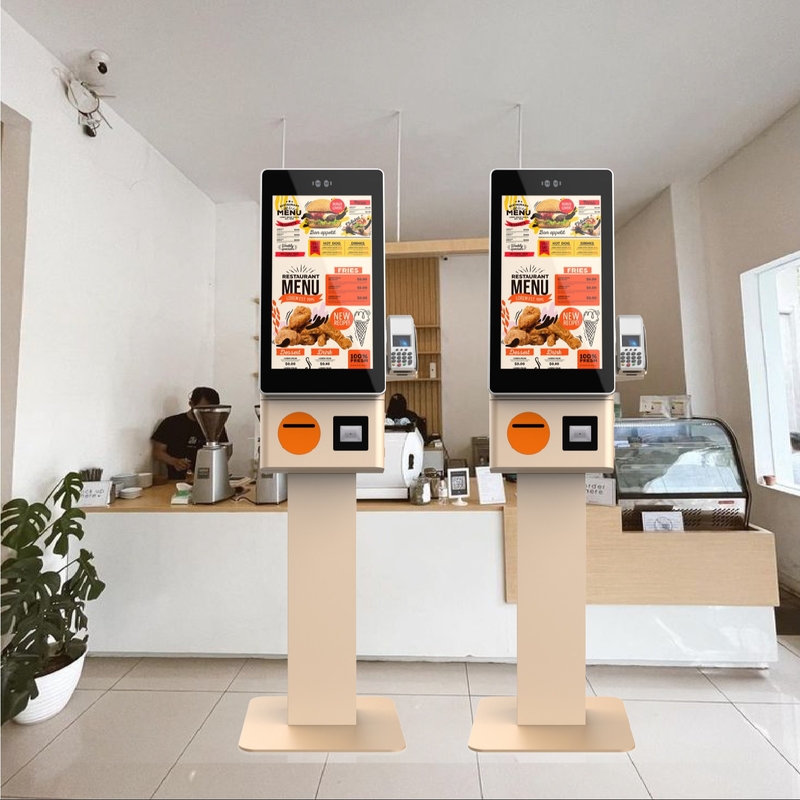
As a professional kiosk manufacturer, it is important to deeply understand the profound impact that self ordering kiosks have on restaurants, particularly in terms of improving operations, increasing convenience, and enhancing customer satisfaction. Below is an in-depth analysis of how these kiosks influence the restaurant industry.
Self ordering kiosks streamline the order-taking process, removing the need for staff to manually input orders. Orders go directly to the kitchen, reducing the chances of human error, minimizing miscommunication, and speeding up service. Key operational improvements include:
Reduced Labor Dependency: Fewer front-of-house staff are needed, allowing restaurants to reallocate labor to other tasks or cut down on staffing costs.
Faster Turnaround Times: Orders are processed and sent to the kitchen almost instantaneously, helping restaurants handle peak hours more efficiently.
Decreased Waiting Time: Customers can order as soon as they walk in, or even before they sit down, reducing perceived wait times significantly.
Self ordering kiosks offer a convenient and engaging way for customers to place their orders:
Customization: Customers have full control over customizing their orders, such as modifying ingredients or adjusting portion sizes. This personalizes their experience and enhances satisfaction.
Reduction of Human Errors: Kiosks eliminate mistakes caused by verbal miscommunication, leading to more accurate orders and reducing food wastage.
Visual Menus: High-quality images and easy-to-navigate interfaces help customers make better choices, often encouraging them to add extras they might not have considered when ordering through staff.
Self ordering kiosks provide subtle ways to boost sales through upselling and cross-selling:
Automated Upselling: Kiosks can be programmed to suggest add-ons, sides, or drinks as customers proceed with their orders, effectively promoting higher-ticket items.
Promotions and Deals: Special offers or discounts can be highlighted directly on the interface, encouraging customers to take advantage of meal deals or combo offers.
Larger Average Order Size: Data suggests that customers tend to spend more when ordering through kiosks, as they feel less pressure and have time to explore the full menu.
While initial investment in self ordering kiosk can be significant, they result in long-term cost savings:
Labor Cost Reduction: Fewer front-of-house staff are needed to take orders, as kiosks handle this aspect, enabling labor optimization.
Operational Scalability: Self ordering kiosks allow restaurants to manage larger volumes of orders without having to proportionally increase staff. This makes scaling operations more affordable.
Energy Efficiency: Modern kiosks are energy efficient, reducing the overall utility cost, particularly in large-scale restaurant chains.
Self ordering kiosks are powerful tools for gathering customer data and insights:
Order Preferences: Detailed data on what customers order, how often, and in what combinations provide valuable insights for menu optimization.
Customer Demographics: Track customer preferences by time, date, and demographic, helping restaurant owners adjust menu offerings and promotions.
Real-Time Data: Kiosks can deliver real-time data to restaurant management, offering insights into order trends, peak times, and sales volume.
Self ordering kiosks contribute to higher customer satisfaction, which in turn fosters loyalty:
Speed and Convenience: By reducing wait times and allowing customers to place orders at their own pace, kiosks create a seamless experience, especially during rush hours.
Loyalty Programs: Kiosks can integrate with existing loyalty programs, allowing customers to accumulate and redeem rewards easily, which encourages repeat visits.
As consumer preferences shift towards faster, more convenient dining experiences, self ordering kiosks play a key role in meeting these expectations:
Contactless Ordering: In the wake of increased demand for contactless interactions, kiosks enable customers to order and pay without touching cash or interacting with staff, enhancing health and safety measures.
Multilingual Interfaces: Restaurants can cater to diverse customer bases by offering multiple language options on the kiosk interface, improving accessibility and inclusivity.
In conclusion, self ordering kiosks have a transformative impact on restaurants by improving operational efficiency, increasing revenue through upselling, and enhancing customer satisfaction. Restaurants adopting this technology see a significant return on investment, as the kiosks reduce labor costs, improve order accuracy, and speed up service. As consumer demand for convenience and personalization continues to grow, self ordering kiosks are becoming an indispensable tool in the modern restaurant industry.
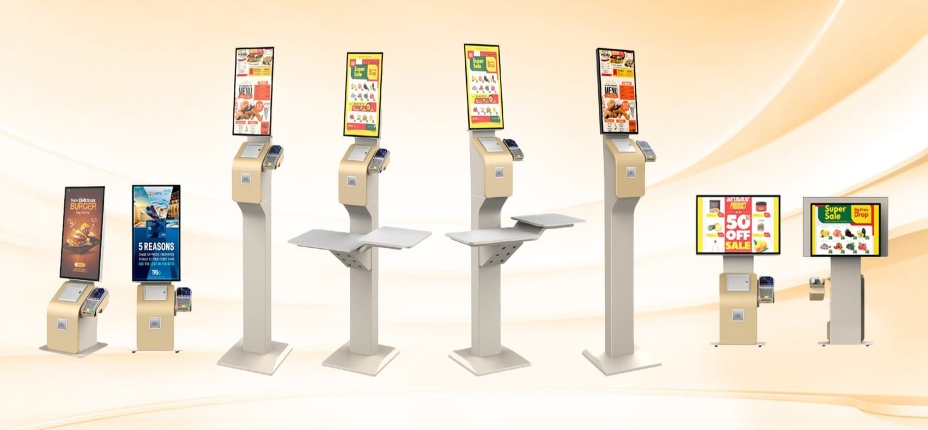
As a professional kiosk manufacturer, providing an in-depth analysis of the Return on Investment (ROI) for self ordering kiosks in restaurants is crucial for understanding their financial impact. Below is a detailed breakdown of how restaurants can measure ROI and the various factors that contribute to positive returns.
The first consideration for ROI is the upfront investment required for purchasing and installing self ordering kiosks. These costs can vary based on:
Hardware: The type of kiosk hardware (touchscreen size, durability, payment systems) affects the initial price. Premium models with advanced features like cash acceptance, receipt printers, and large displays will cost more.
Software: Customization of software, including POS integration, loyalty programs, or custom features, increases the initial setup costs.
Installation and Setup: Professional installation services are needed to integrate the kiosk with existing restaurant systems.
Maintenance and Support: Ongoing technical support and software updates are required to keep the kiosk running smoothly.
Despite the significant upfront costs, self ordering kiosks often offer substantial long-term savings, contributing to a quicker ROI.
One of the most significant drivers of ROI for self ordering kiosks is the reduction in labor costs. By automating the order-taking process, restaurants can:
Reduce Front-of-House Staffing Needs: Fewer cashiers are needed to take orders, which translates to lower wage expenses.
Labor Reallocation: Employees can be reassigned to other critical areas, such as food preparation or customer service, rather than taking orders.
Operational Scalability: Restaurants can handle increased order volumes without needing to proportionally increase staff, which is particularly beneficial during peak hours.
This reduction in staffing costs often leads to quicker payback on the kiosk investment, particularly for larger or chain restaurants where labor costs represent a significant portion of operating expenses.
Self ordering kiosks are highly effective tools for increasing order sizes through automated upselling:
Prompts for Add-Ons: The kiosk can suggest additional items, such as drinks, desserts, or sides, at the point of order, leading to higher average ticket sizes.
Personalized Recommendations: Based on customer preferences or past orders, the system can suggest higher-margin items or meal upgrades.
Consistency in Upselling: Unlike human staff, kiosks are programmed to consistently promote additional items, ensuring that every customer receives upsell suggestions.
Research shows that customers are more likely to add extras when presented with clear, visual options, leading to an increase in average transaction value. This revenue boost directly contributes to a faster ROI.
Self ordering kiosks also contribute to ROI by reducing errors and minimizing food waste:
Accurate Orders: With customers directly entering their preferences, there is less room for errors compared to verbal communication with staff. This improves accuracy and reduces the likelihood of wrong orders.
Lower Food Wastage: Fewer order mistakes mean less food is discarded due to incorrect preparation, saving on food costs.
By minimizing errors, restaurants can save significantly on both food and labor costs associated with correcting mistakes, improving overall profitability.
Speed is a critical factor in restaurant profitability, and self ordering kiosks help streamline operations by:
Shortening Wait Times: Customers can place orders more quickly, reducing the time spent in queues and improving table turnover rates.
Faster Order Processing: Orders are sent directly to the kitchen in real-time, reducing delays and improving operational flow.
Increased Capacity: Restaurants can handle more orders during peak periods without being limited by staff availability.
These factors enable restaurants to serve more customers in less time, thereby boosting sales and improving operational efficiency, which contributes to ROI.
Self ordering kiosks generate valuable data that can be used to optimize operations and marketing strategies:
Customer Preferences: Restaurants can track popular items and customer preferences, helping to adjust the menu or promote high-margin dishes.
Sales Trends: Real-time sales data allows for better inventory management and more strategic promotions.
Loyalty Program Integration: Kiosks can integrate with loyalty programs, encouraging repeat customers and increasing lifetime value.
Leveraging this data helps restaurants make data-driven decisions, optimize inventory, and create targeted marketing campaigns, all of which enhance profitability.
The combination of reduced labor costs, increased avera
ge order size, improved accuracy, and higher efficiency leads to a faster payback period for self ordering kiosks. Depending on the restaurant size and volume of customers, the payback period can range from 6 months to 18 months, making kiosks a sound investment.
Once the initial costs are recovered, self ordering kiosks continue to provide long-term savings and revenue growth:
Ongoing Revenue Growth: Upselling and promotional features consistently contribute to higher sales.
Low Maintenance Costs: Modern kiosks are designed for durability, with minimal maintenance required beyond regular software updates.
Scalability: As the restaurant grows, adding more kiosks is more cost-effective than hiring additional staff, making kiosks a scalable solution.
In summary, the ROI of self ordering kiosks for restaurants is driven by reduced labor costs, increased revenue through upselling, improved order accuracy, and enhanced operational efficiency. The data-driven insights and scalability of kiosks further support long-term profitability. For restaurants, the implementation of self ordering kiosks can result in a faster payback period and sustained financial benefits over time.
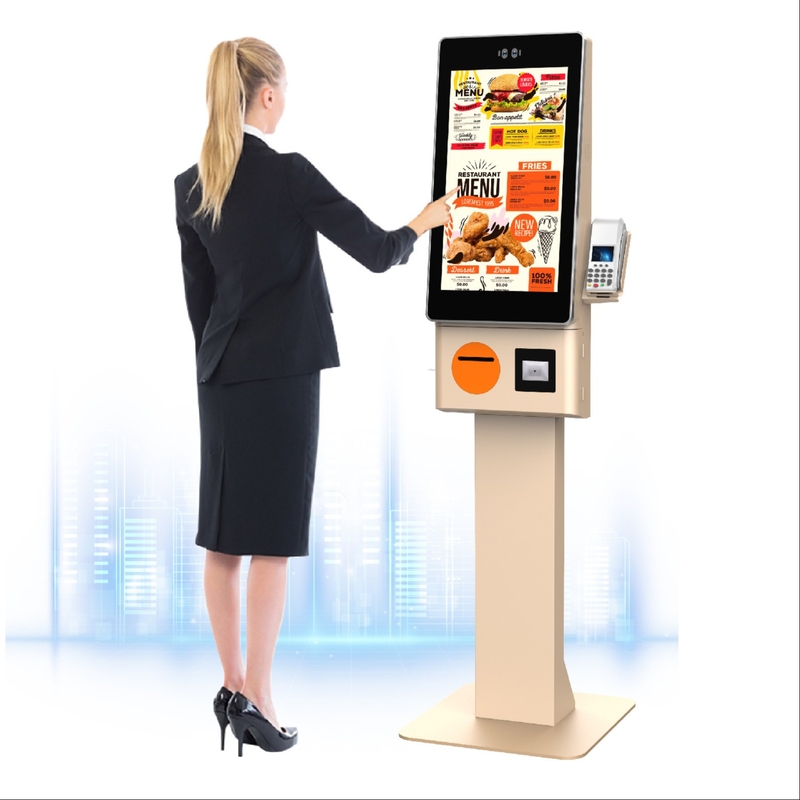
As a professional kiosk manufacturer, it’s important to provide a detailed overview of the installation and setup process of a self-ordering kiosk for restaurants. Here’s a breakdown of the key steps involved:
Space Allocation: Before installation, the restaurant needs to determine the optimal location for the kiosk. Factors like customer flow, visibility, and proximity to the ordering counter or entrance are important. The kiosk should be positioned where it enhances the ordering experience without obstructing customer movement.
Power and Internet Requirements: The kiosk will require both a stable power source and internet connection (either Wi-Fi or Ethernet) to communicate with the POS system and process payments. The installation site should be prepared with accessible power outlets and network ports.
Environmental Considerations: If installing an outdoor kiosk, weatherproofing features and protection from the elements are essential.
Mounting the Kiosk: Depending on the design (freestanding, countertop, or wall-mounted), the kiosk needs to be securely mounted. For freestanding units, ensure they are stable on the floor, while wall-mounted kiosks require proper drilling and securing to prevent accidents.
Connecting Power and Internet: The kiosk’s power cable and Ethernet connection (if applicable) should be routed through secure channels. It is critical to ensure cables are hidden or protected to avoid damage or tripping hazards.
Peripheral Installation: Additional hardware components such as receipt printers, payment terminals, and bill validators need to be properly integrated into the kiosk and connected to the main system. For payment terminals, compliance with PCI-DSS (Payment Card Industry Data Security Standard) regulations must be ensured.
POS System Integration: The self-ordering kiosk must be integrated with the restaurant's existing POS system for seamless order and payment processing. This allows real-time synchronization of menu items, pricing, and inventory management.
Menu Customization: The restaurant’s menu must be uploaded and customized for the kiosk interface. This involves adding menu items, images, descriptions, pricing, and any customizable options such as portion sizes, add-ons, or dietary restrictions. Restaurants should ensure the user interface is intuitive and visually engaging.
Payment Gateway Setup: If the kiosk supports multiple payment methods (e.g., credit cards, mobile wallets, or cash), the corresponding payment gateways need to be configured. Secure encryption and tokenization methods should be implemented to ensure transaction security.
Loyalty Program Integration: If the restaurant has a loyalty or rewards program, this can be integrated into the kiosk system, allowing customers to earn and redeem points directly through the kiosk.
System Testing: After installation, the entire system needs to be tested for functionality. This includes checking the touch screen’s responsiveness, verifying the payment system, and ensuring that orders are accurately transmitted to the kitchen. Any hardware components such as printers or scanners should also be tested.
Network Stability: Ensure that the internet connection is stable and secure, as the kiosk will rely on this for communication with the restaurant’s central system and payment processing.
Calibration: The touch screen and any other input devices should be calibrated to ensure accuracy and ease of use for customers.
Basic Operation: Restaurant staff should be trained on how to use the kiosk, including how to handle basic troubleshooting, restart the system if needed, and guide customers through the ordering process if necessary.
Maintenance and Support: Staff should also be trained on daily maintenance tasks such as paper refills for receipt printers and keeping the kiosk clean. Additionally, they should know how to contact technical support for any issues beyond their capability.
Data Protection: It's essential to ensure that the kiosk’s software is secure, particularly when handling customer payment data. Firewalls, anti-virus software, and encryption technologies should be installed to prevent data breaches.
Physical Security: For freestanding kiosks, locks or enclosures may be necessary to prevent tampering or theft. Additionally, security cameras should be considered for monitoring kiosk activity.
Remote Monitoring: Many kiosks offer remote diagnostics and monitoring, allowing the restaurant or the kiosk provider to track performance, monitor for hardware or software issues, and push updates remotely.
Software Updates: Over time, the kiosk may require software updates for improved functionality, security, or compatibility with new restaurant systems. These updates should be scheduled during non-peak hours to avoid disruptions.
Regular Maintenance: Restaurants should establish a maintenance schedule, including cleaning the kiosk, inspecting cables and components, and updating the software regularly to ensure long-term performance.
Technical Support: In case of hardware malfunctions or software errors, technical support should be readily available to resolve issues promptly. This minimizes downtime and keeps the kiosk operational.
The installation and setup process of self ordering kiosks for restaurants involves a comprehensive approach, from site preparation to ongoing maintenance. As a professional kiosk manufacturer, understanding each step ensures the smooth integration of these kiosks into restaurant operations, ultimately improving efficiency, customer experience, and revenue. Proper installation, combined with regular updates and maintenance, guarantees long-term success and a high ROI for the restaurant.

As a top kiosk manufacturer, we continuously monitor the latest industry trends and innovations in the self ordering kiosk for restaurants. Below is a detailed analysis of the key developments shaping this technology:
Personalized Recommendations: AI-driven kiosks can analyze customer preferences and suggest menu items based on past orders or trends. This enhances the customer experience by providing personalized meal options and promotions.
Demand Forecasting: Machine learning algorithms help predict peak hours and preferred menu items, allowing restaurants to adjust their inventory and staffing levels accordingly.
Voice Recognition: Increasingly, self ordering kiosks are integrating voice recognition to provide a hands-free ordering experience, particularly for customers with disabilities or those in a rush.
Enhanced Payment Security: Kiosks are adopting advanced encryption and tokenization to enhance payment security, ensuring customers' card details are protected during transactions.
Contactless Payments: With the rise of mobile wallets (e.g., Apple Pay, Google Pay) and contactless cards, kiosks are increasingly supporting NFC-based payments, providing a faster and more hygienic transaction process.
QR Code Payments: Some kiosks now allow customers to scan a QR code to pay through their mobile banking app, making the payment process even more versatile.
Remote Monitoring and Updates: Cloud connectivity allows restaurant managers to monitor kiosks in real time, track sales data, and implement system updates remotely. This minimizes the need for on-site maintenance and enhances kiosk uptime.
Data Analytics: Restaurants can leverage kiosk data to gain insights into customer preferences, peak usage times, and sales trends. This helps in optimizing the menu, managing inventory, and improving operational efficiency.
Intuitive Touch Screens: Newer self ordering kiosks are equipped with higher-resolution touch screens that provide a smoother, more responsive user experience. These displays are designed to be highly intuitive, even for customers unfamiliar with digital ordering systems.
Multilingual Support: To cater to diverse demographics, self ordering kiosks now offer multilingual options, making them accessible to a broader customer base.
Dynamic Menus: Restaurants are increasingly utilizing dynamic digital menus that change based on time of day, customer preferences, or promotions, helping streamline the customer’s decision-making process.
Energy Efficiency: Manufacturers are designing kiosks with energy-efficient components, such as LED screens and low-power processors, reducing overall energy consumption.
Paperless Transactions: By promoting digital receipts over printed ones, kiosks contribute to reducing paper waste, aligning with growing sustainability goals across the industry.
Eco-Friendly Materials: The production of self ordering kiosks is incorporating more eco-friendly materials, such as recyclable metals and plastics, contributing to reduced environmental impact.
Interactive Menus: Some kiosks are experimenting with AR to create interactive 3D visualizations of menu items, allowing customers to get a better sense of portion sizes and presentation before placing their order.
Enhanced Customer Engagement: AR elements, such as games or interactive promotions, engage customers while they wait for their food, enhancing the overall dining experience.
Unified Ordering Experience: Self ordering kiosks are becoming part of a broader omnichannel strategy, integrating with mobile apps, drive-thru systems, and table-side ordering platforms. This provides a consistent, seamless customer experience across all ordering channels.
Click-and-Collect Integration: Restaurants are adopting click-and-collect options, allowing customers to place an order via the kiosk and pick it up at a designated time, reducing wait times and enhancing convenience.
Sanitization Technologies: In the wake of the COVID-19 pandemic, kiosks are incorporating features like antimicrobial screens and automatic cleaning systems to ensure hygiene and safety.
Social Distancing Measures: Many kiosks are designed to reduce physical contact between customers and staff, supporting safer, more contactless transactions.
Smart Kitchens: Self ordering kiosks are increasingly integrated with IoT devices in the kitchen. When an order is placed, it is automatically routed to the relevant kitchen station, optimizing workflow and reducing manual errors.
Inventory Management: IoT sensors connected to the kiosk system can provide real-time inventory tracking, automatically adjusting the menu based on stock availability.
The self ordering kiosk industry is experiencing rapid innovation, with emerging technologies like AI, IoT, and AR driving the future of restaurant operations. These trends are helping restaurants improve efficiency, enhance customer experience, and reduce costs. As a leading kiosk manufacturer, we are at the forefront of these trends, continuously developing solutions that meet the evolving needs of the restaurant industry. Investing in self ordering kiosks today not only boosts operational efficiency but also future-proofs businesses in an increasingly digital world.
Self ordering kiosk for restaurants bring substantial convenience and operational advantages. By allowing customers to place orders and make payments through intuitive touch screens, these kiosks reduce wait times, enhance order accuracy, and offer a personalized dining experience. Customers can customize their meals, view promotions, and choose from various payment options, including card, mobile, and cash. Integration with restaurant POS systems enables real-time inventory management and seamless sales reporting. Additionally, self ordering kiosks boost efficiency by directly sending orders to the kitchen, minimizing errors, and speeding up service. This technology, supported by AI-driven analytics, contactless payment options, and sustainability features, positions restaurants to cater to modern consumer demands while driving revenue growth.
Address: No. 99-15, Fuan intelligent manufacturing Industrial Park, Dayang Road, Fuhai Street, Baoan District, Shenzhen, China